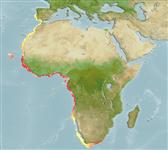Classification / Names
Common names from other countries
Main reference
Size / Weight / Age
Max length : 50.0 cm TL male/unsexed; (Ref. 2683); common length : 30.0 cm TL male/unsexed; (Ref. 2683)
Environment
Marine; benthopelagic; depth range 50 - 500 m (Ref. 2683), usually 100 - 500 m (Ref. 26999)
Climate / Range
Deep-water, preferred 27°C (Ref. 107945)
Distribution
Eastern Atlantic: Cape Blanc, Mauritania to the Kunene River, Angola. Reported from Namibia (Ref. 27121). Western Atlantic: occurrence in Venezuela is based on 4 samples taken from the coast, of which only one is larger than 20 cm TL (Ref. 13628).
Countries | FAO areas | Ecosystems | Occurrences | Introductions
Short description
IUCN Red List Status (Ref. 115185)
Threat to humans
Harmless
Human uses
Fisheries: commercial
More information
Common namesSynonymsMetabolismPredatorsEcotoxicologyReproductionMaturitySpawningFecundityEggsEgg development
ReferencesAquacultureAquaculture profileStrainsGeneticsAllele frequenciesHeritabilityDiseasesProcessingMass conversion
Tools
Special reports
Download XML
Internet sources
Estimates of some properties based on models
Phylogenetic diversity index
PD50 = 0.5039 many relatives (e.g. carps) 0.5 - 2.0 few relatives (e.g. lungfishes)
Trophic Level
4.0 ±0.28 se; Based on food items.
Resilience
Medium, minimum population doubling time 1.4 - 4.4 years (Preliminary K or Fecundity.)
Vulnerability
Moderate vulnerability (45 of 100)
Price category
